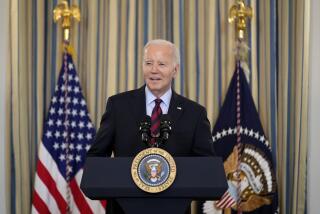A snapshot of poverty in the U.S.
- Share via
A new Census Bureau report confirms that the slowly rising tide of the U.S. economy hasn’t lifted all boats. The 20% of Americans with the highest incomes captured an even larger share of the earnings in 2011, while the rest collected the same share or less. The widening income inequality is disturbing, but as the report shows, things could have been considerably worse. Without such safety net programs as unemployment benefits and food stamps, millions more families would have fallen into poverty.
The bureau’s annual reports on income, poverty and health insurance are like group photos taken from an extremely high altitude. The year-to-year comparisons offered don’t reveal anything about income mobility or the ability of people to move up (or down) the economic ladder. But they do show that the vast majority of Americans continue to see their fortunes slide. In 2011 the median income fell for the fifth year in a row, to $51,000 — a drop of 1.5%. It fell for all four ethnic groups tracked by the census (although only slightly for Latinos), and for women and men alike. The exception was in the top 20% of U.S. incomes, which held steady.
The result: The share of U.S. earnings collected by the highest-income Americans grew, while the share collected by the middle 60% fell. The bottom 20% saw no change, but the gap between the rich and poor was the largest on record. As long as the fruits of the recovery are modest and reaped mainly by the highest incomes, the median income will continue to drop and the poverty rate won’t go down.
The glimmer of encouragement in the report was that the poverty rate stayed at 15%, the same as in 2010, after rising for four years. (The rate is the percentage of households with incomes below the federal poverty line, which in 2011 was $23,200 for a family of four). That’s roughly where the rate was in the early 1980s and early 1990s; it falls during boom times and rises when unemployment surges. Part of the explanation for the leveling off was the growth in year-round, full-time employment among lower-income Americans. That’s a good-news, bad-news statistic; it reflects the fact that most of the jobs being created in the recovery are lower-wage jobs.
The federal poverty rate is based on pretax, inflation-adjusted income, which doesn’t factor in benefits provided by such anti-poverty programs as subsidized housing, Medicaid and food stamps, although it does include unemployment benefits. Economists Bruce D. Meyer of the University of Chicago and James X. Sullivan of the University of Notre Dame have argued that disposable income and consumption data provide better measures of poverty; their analysis shows that the percentage of impoverished Americans has dropped significantly over the last three decades. Even Meyer and Sullivan’s numbers show, however, that the most recent downturn drove up the incidence of poverty.
More Americans would have been impoverished last year if not for federal and state governments’ spending on safety net programs. According to the Census Bureau, unemployment benefits kept 2.3 million Americans from falling into poverty. If the earned income tax credit had been factored in, 5.7 million people would have been lifted above the poverty line. If food stamps were considered, 3.9 million Americans would no longer be counted among the impoverished.
Those programs help the overall economy by propping up the demand for goods, but they cost billions. Congress, which expanded all three programs as part of the 2009 economic stimulus package, has struggled to decide when to pull them back; liberals have argued that the economy isn’t strong enough yet, and conservatives have argued that the aid discourages people from getting back to work.
With 3 1/2 job seekers for every opening, it’s hard to argue that unemployment would drop significantly if the jobless were more desperate for cash. In fact, according to the Census Bureau’s numbers, the reductions that Congress made in unemployment benefits last year resulted in nearly 1 million more people in poverty, even as more people found jobs. Nevertheless, those benefits are slated to be cut further later this year, along with tax credits for the working poor and low-income parents. Congress is also considering a new farm bill that would narrow eligibility for food stamps. With the economy growing so sluggishly, all of these reductions seem premature and counterproductive.
The best solution to these problems is returning to full employment. Not only does lower unemployment translate reliably into less poverty, but a tight labor market drives up wages, raising the median income. That’s when the rising tide would truly lift all boats. A second focus for policymakers should be preparing workers better for the jobs that are being created, which means improving education and training programs.
In the meantime, though, lawmakers should resist the impulse to cut spending on unemployment benefits, tax credits and other targeted aid to the poor. The demand for that aid will drop on its own once the economy is back at full strength, but we’re not there yet.
More to Read
A cure for the common opinion
Get thought-provoking perspectives with our weekly newsletter.
You may occasionally receive promotional content from the Los Angeles Times.










